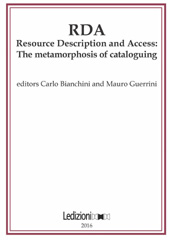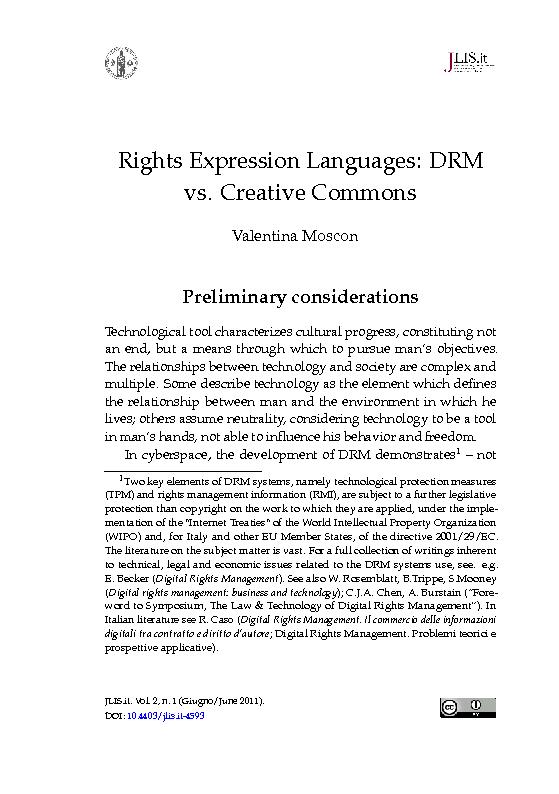Rights Expression Languages : DRM vs : Creative Commons
1-26 p.
Lo sviluppo delle nuove tecnologie e l'utilizzo sempre più ampio del web hanno trasformato radicalmente la riproduzione e la diffusione dell'informazione. Il panorama vede contrapposto un approccio legato al rigido mantenimento dei diritti d'autore, attraverso l'utilizzo di Digital Rights Management (DRM), a nuove e più elastiche soluzioni, come quelle rappresentate dalle Creative Commons Licenses (CCLs). I DRM hanno lo scopo di rendere riconoscibili da software le restrizioni su utilizzo e circolazione dell'oggetto digitale, rendendolo immodificabile e ad accesso ristretto. Le licenze CC, invece, nascono dalla necessità di contrastare un rigido e centralizzato controllo della conoscenza, cercando di accrescere la collaborazione online.
Le licenze CC danno all'utente libertà di accesso, di riproduzione e di distribuzione della risorsa e permettono all'autore di scegliere il livello di protezione dell'opera, consentendo o negando l'uso commerciale o la modifica di essa, o imponendo l'obbligo di mantenere lo stesso tipo di diritti sulle opere derivate. Il movimento alla base delle licenze Creative Commons rappresenta un punto di riferimento sia sotto l'aspetto ideologico che tecnologico; infatti, il procedimento con cui i DRM riescono ad essere efficaci nel controllo della diffusione dell'informazione viene impiegato nelle licenze CC per facilitare e incrementare la diffusione e l'utilizzo dei contenuti, con un controllo flessibile e decentralizzato. L'articolo si propone di descrivere i due modelli, evidenziandone le differenze e gli scopi. [Testo dell'editore].
IT technologies and especially the progressive use of Internet have transformed the mechanism of knowledge transmission and its reproduction. We find, on the one hand, a model of knowledge circulation based on contract self-enforcement, through technological protection measures (TPMs). This kind of control is identified in Digital Rights Management (DRM), whose goal is to make the license terms for access and use of information recognizable by the software and equipment made for the use of information. Through DRM systems an automatic application (in personal computers, mobile phones, televisions, etc.) of contractual rules used for the distribution of digital contents is possible. On the other hand, stands the idea of Creative Commons Language which starts from the need to contrast the risk that a rigid and centralized control might colonize knowledge and above all to enhance the use of information technologies, Network, Web and new intermediaries.
(institutional archives, Internet search engines such as Google Books Search and Google Scholar, etc.). This latter aspect presents features of particular interest and is worthy of attention in this paper. The circulation of information on the Web becomes a key issue. Indeed, if the main purpose of Creative Commons is to ensure maximum diffusion and reuse of information and if the main space for the circulation of content is represented by the Web, the studies on cataloguing techniques, classification of information and the relevant rights in virtual spaces deserve special care. According to Creative Commons licenses (CCLs), the development and evaluation of knowledge are based on the collaboration of an open community of persons.
The CC movement represents a landmark, not only from an ideological and contractual point of view, but also from a technological one: CC licenses, using some system technologies similar to those of DRM, appear to users in a readable form and also in a machine-readable form. The technologies which allow DRM systems to exercise strict control over information are developed by CC to facilitate the diffusion and the use of content, aiming at a flexible and decentralized control. The essay is intended to first provide a brief description of the IT technologies developed in DRM systems and by Creative Commons and then, for the translation of rules into IT code, to highlight the differences and, especially, the various achieved purposes. [Publisher's Text].
-
Articles from the same issue (available individually)
-
Information



